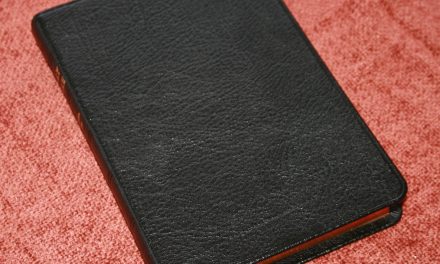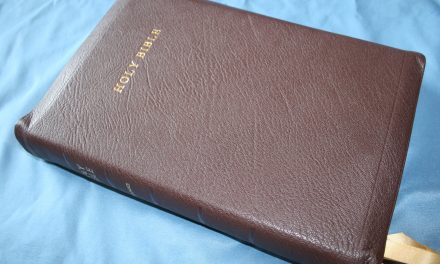While not a Bible translation and not to be used in place of reading the Bible, The Message can be a valuable reading tool to read along with your Bible, and I can’t imagine a better layout to read than this one. In this review I take a look at The Message Catholic Ecumenical Edition in paperback. This is a work by Eugene Peterson and William Griffin.
ISBN: 9780879464943
Materials
This is a large paperback edition with 1984 pages (counting a few blank pages in the back). It has a glued binding with paper in the upper 20s or low 30s in gsm. The paper has a decent opacity and has a soft white color with no glare under direct lighting. The overall size is 9 x 6 x 1.25”
Typography
It’s single column paragraph with poetry in stanzas, letters indented, and Old Testament quotes set apart so it stands out. Book names and chapter numbers are placed in the outer margin of the header while page numbers are placed in the outer margin of the footer.
The font is close to 9-point. It’s black letter and has about a medium darkness. It seems to be printed with line-matching. There are a few pages that don’t line up, but not many. If it wasn’t done on purpose then I’m impressed and pleased with the happy accident. It has around 72 characters per line, giving space for 12-14 words per line and 51 lines per page. Words never feel cramped.
What’s so special about the layout is the placement of the verse numbers. The verse numbers are not placed within the text. Instead, the range of verses is placed in the margin at the beginning of each paragraph. This keeps the text clean and free of distractions. This layout is familiar to readers of The Message. I’d love to see this layout in the popular translations.
Chapter numbers are used as a drop-cap and take three lines. They’re printed in a dark shade of gray so there isn’t too much contrast. They look stylish without getting in the way of the design.
Section headings are centered. Some sections end with a burst icon (resembling sunshine). This creates a lot of whitespace on the page and makes the layout even more readable. Of course this also separates the text into smaller thoughts which can detach it from the rest of the context, but that’s what happens with section headings and I recommend reading in large chunks anyway.
Section and Book Introductions
Section and book introductions are printed over a darker background to help them stand out from the text.
Section introductions (the books of Moses, history, wisdom, prophets, and the New Testament) take 2-3 pages and describe the genre of writing, culture, circumstances the writers and other characters had to face, the way they thought, problems they dealt with, and lots more. They help set the stage for that section of books.
Book introductions take from a half to two pages and talk about the land, people, culture, and even some thoughts on application. Peterson and Griffin do an excellent job at putting the reader into the shoes of the writer, helping us to understand the writers and their audiences better.
Apocrypha
What makes this a Catholic edition is the inclusion of the Apocryphal books (or “Deuterocanonical writings”) placed throughout the Old Testament rather than at the end of the OT. This work, including the introductions, was done by William Griffin.
This includes:
- Tobit
- Judith
- Esther (Catholic version)
- 1 Maccabees
- 2 Maccabees
- Wisdom
- Sirach
- Baruch
- Daniel (chapters 13 and 14)
Conclusion
The Message Catholic Ecumenical Edition, like any paraphrase, shouldn’t be used in place of Scripture for study. However, it can be a valuable reading tool and the readability of this edition is as good as it gets. Catholic readers will appreciate the inclusion of the Deuterocanonical writings. Rather than performing the work himself when he didn’t feel qualified, Eugene Peterson recruited William Griffin to produce the Apocryphal books, which is something I can appreciate.
The layout is where this edition shines. The design greatly improves readability while still providing verse numbers off to the side. Showing a range of verses at the beginning of a paragraph rather than showing each verse helps keep the margins cleaner, making them less distracting. It is more difficult to know where a specific verse starts, but the readability is so much better that I’m fine with this. I’d love to see regular translations use this layout.
The Message Catholic Ecumenical Edition is available in paperback, hard cover, and for Kindle. Click here to buy from Amazon.
Visit The Message Catholic Ecumenical Edition website for more information.
Photography by hannah C brown
ACTA Publications provided this edition free for review. I was not required to give a positive review – only an honest review. My opinions are my own.


























I have had this Bible since it was released (in hardback). I would never use it for serious study, but I have to admit that it often words things in such a way that it makes me want to look up other translations and do serious study in the original languages and commentaries.
Here is Psalm 1
How well God must like you—
you don’t hang out at Sin Saloon,
you don’t slink along Dead-End Road,
you don’t go to Smart-Mouth College.
Instead you thrill to God’s Word,
you chew on Scripture day and night.
You’re a tree replanted in Eden,
bearing fresh fruit every month,
Never dropping a leaf,
always in blossom.
You’re not at all like the wicked,
who are mere windblown dust—
Without defense in court,
unfit company for innocent people.
God charts the road you take.
The road they take is Skid Row.
I wish they would produce a more attractive edition (faux leather would be fine!) in larger print.
vladimir998